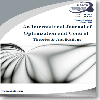Fitting intravoxel incoherent motion model to diffusion MR signals of the human breast tissue using particle swarm optimization
Fitting intravoxel incoherent motion model to diffusion MR signals of the human breast tissue using particle swarm optimization
___
- Le Bihan, D. & Lima, M. (2015). Diffusion magnetic resonance imaging: What water tells us about biological tissues. PLoS Biology, 13(7): e1002203. http://doi.org/10.1371/journal.pbio.1002203.
- Pinker, K., Moy, L., Sutton, E.J., Mann, R.M., Weber, M., Thakur, S.B., Jochelson, M.S., Bago- Horvath, Z., Morris, E.A., Baltzer, P.A. & Helbich, T.H. (2018). Diffusion-weighted imaging with apparent diffusion coefficient mapping for breast cancer detection as a stand-alone parameter: comparison with dynamic contrast-enhanced and multiparametric magnetic resonance imaging. Investigative Radiology. http://doi:10.1097/RLI.0000000000000465.
- Pasquier, D., Hadj Henni, A., Escande, A., Tresch, E., Reynaert, N., Colot, O., Lartigau, E. & Betrouni, N. (2018). Diffusion weighted MRI as an early predictor of tumor response to hypofractionated stereotactic boost for prostate cancer. Scientific Reports, 8, 10407. http://doi.org/10.1038/s41598- 018-28817-9.
- Keil, V. C., Mädler, B. , Gielen, G. H., Pintea, B. , Hiththetiya, K. , Gaspranova, A. R., Gieseke, J. , Simon, M. , Schild, H. H. & Hadizadeh, D. R. (2017). Intravoxel incoherent motion MRI in the brain: Impact of the fitting model on perfusion fraction and lesion differentiability. Journal of Magnetic Resonance Imaging, 46(4), 1187-1199.
- Barbieri, S., Donati, O.F., Froehlich, J.M. & Thoeny, H.C. (2016). Impact of the calculation algorithm on bi-exponential fitting of diffusion-weighted MRI in upper abdominal organs. Magnetic Resonance in Medicine, 75(5), 2175-2184.
- Marquardt, D.W. (1963). An algorithm for least- squares estimation of nonlinear parameters. Journal of the Society for Industrial and Applied Mathematics, 11(1), 431-441.
- Coleman, T.F. & Li, Y. (1996). An interior, trust region approach for nonlinear minimization subject to bounds. SIAM Journal on Optimization, 6(1), 418- 445.
- Kennedy, J. & Eberhart, R. (1995). Particle swarm optimization. Proceedings of the IEEE International Conference on Neural Networks, 1942-1945.
- Devraj Mandal, D., Chatterjee, A. & Maitra, M. (2014). Robust medical image segmentation using particle swarm optimization aided level set based global fitting energy active contour approach. Engineering Applications of Artificial Intelligence, 35(1), 199-214.
- Kaur, S. & Kaur, M. (2010) Medical image enhancement using particle swarm optimization. Artificial Intelligent Systems and Machine Learning, 2(5), 54-59.
- Lin, C.-L., Mimori, A. & Chen, Y.-W. (2012). Hybrid particle swarm optimization and its application to multimodal 3D medical image registration. Computational Intelligence and Neuroscience, 561406. http://doi.org/10.1155/2012/561406.
- Le Bihan, D., Breton, E., Lallemand, D., Grenier, P., Cabanis, E. & Laval-Jeantet, M. (1986). MR imaging of intravoxel incoherent motions: application to diffusion and perfusion in neurologic disorders. Radiology, 161(2), 401-417.
- Liu, C., Liang, C., Liu, Z., Zhang, S. & Huang, B. (2013). Intravoxel incoherent motion (IVIM) in evaluation of breast lesions: comparison with conventional DWI. European Journal of Radiology, 82(12): e782-9. http://doi:10.1016/j.ejrad.2013.08.006.
- Cho, G. Y., Moy, L., Zhang, J. L., Baete, S., Lattanzi, R., Moccaldi, M. & Sigmund, E.E. (2015). Comparison of Fitting Methods and b-Value Sampling Strategies for Intravoxel Incoherent Motion in Breast Cancer. Magnetic Resonance in Medicine, 74(4), 1077–1085.
- Harel, O. (2009). The estimation of R2 and adjusted R2 in incomplete data sets using multiple imputation. Journal of Applied Statistics, 36(10), 1109-1118.
- Zhou, T. & Han, D. (2008). A weighted least squares method for scattered data fitting. Journal of Computational and Applied Mathematics, 217(1), 56-63.
- While, P. T. (2017). A comparative simulation study of bayesian fitting approaches to intravoxel incoherent motion modeling in diffusion‐weighted MRI. Magnetic Resonance in Medicine, 78(6), 2373- 2387.
- ISSN: 2146-0957
- Yayın Aralığı: 4
- Yayıncı: Prof. Dr. Ramazan YAMAN
Some integral inequalities for multiplicatively geometrically P -functions
A genetic algorithm for fuzzy order acceptance and scheduling problem
Esra KARAKAŞ, Hakan ÖZPALAMUTÇU
Optimization of medical waste routing problem: The case of TRB1 region in Turkey
Robust reformulations of ambiguous chance constraints with discrete probability distributions
A New Broyden rank reduction method to solve large systems of nonlinear equations
Mostafa OUARİT, Ali SOUISSI, Mohammed ZIANI
Analytical studies on waves in nonlinear transmission line media
Analyzing occupational risks of pharmaceutical industry under uncertainty using a Bow-Tie analysis
Hüseyin YILDIRIM, Abdullah AKKURT, Seda KILINÇ
Stability of delay differential equations in the sense of Ulam on unbounded intervals
